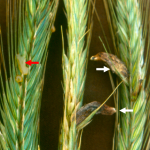Disease Profile: Ergot
 A new disease profile was recently posted describing signs and symptoms of Ergot of rye, wheat, and other grasses and consequences of the disease. Click here to download a PDF of the disease profile.
A new disease profile was recently posted describing signs and symptoms of Ergot of rye, wheat, and other grasses and consequences of the disease. Click here to download a PDF of the disease profile.
 A new disease profile was recently posted describing signs and symptoms of Ergot of rye, wheat, and other grasses and consequences of the disease. Click here to download a PDF of the disease profile.
A new disease profile was recently posted describing signs and symptoms of Ergot of rye, wheat, and other grasses and consequences of the disease. Click here to download a PDF of the disease profile.
The NCERA 184 Management of Small Grain Diseases Fungicide Efficacy for Control of Wheat Diseases Table was recently updated. It is now posted on the wheat page. CLICK HERE to access a PDF version of it.
This brochure is a full color update with information on best management practices for soybean cyst nematode in Wisconsin. CLICK HERE to download a PDF
Listen to the 7-item Podcast Series on “Management of White Mold in Soybeans.” The series was assembled by a consortium of soybean pathologists located in the North Central Region and sponsored by the North Central Soybean Research Program.
The University of Wisconsin Cooperative Extension Service and the UW Integrated Pest Management Program will be offering a series of online webinar training session that are designed to help people prepare for the state CCA exam. Learn more about the webinars at: http://ipcm.wisc.edu/blog/2012/10/training-webinar-for-cca-exam/.
Erin Hodgson, Extension Specialist at Iowa State University offers a how-to lesson on soybean aphid speed scouting.
Visit this link to view an open access webcast on the technique.
Speed scouting is an easier, more efficient method of estimating whether aphids will have a significant economic impact on soybean, helping the grower or consultant more quickly decide if a treatment is warranted.
The presentation also includes some examples of possible treatment decisions and a new paperless way to sample.
Key points about aphid speed-scouting:


